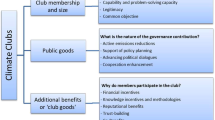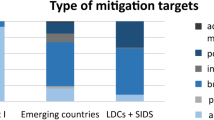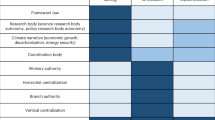Abstract
The Paris agreement has provided a new framework for climate policy. Complementary forms of international collaboration, such as climate clubs, are probably necessary to foster and mainstream the process of gradual and voluntary increase in nationally determined contributions. We provide a quantitative macro-economic assessment of the costs and benefits that would be associated with different climate club architectures. We find that the key benefits that could structure the club are enhanced technological diffusion and the provision of low-cost climate finance, which reduce investment costs and also enables developing countries to take full advantage of technological diffusion. Although they face the highest absolute mitigation cost, China and India are the largest relative winners from club participation because the burden faced by these countries to finance their energy transition can be massively reduced following their participation in the club.
This is a preview of subscription content, access via your institution
Access options
Access Nature and 54 other Nature Portfolio journals
Get Nature+, our best-value online-access subscription
$29.99 / 30 days
cancel any time
Subscribe to this journal
Receive 12 print issues and online access
$209.00 per year
only $17.42 per issue
Buy this article
- Purchase on Springer Link
- Instant access to full article PDF
Prices may be subject to local taxes which are calculated during checkout


Similar content being viewed by others
Data availability
GEM-E3 is calibrated using input-output tables and datasets from EUROSTAT, GTAP 9, 2017 IEA energy statistics and ILO data. A detailed description of the calibration procedure is given in the online manual13.
Code availability
A detailed description of the algorithmic structure of GEM-E3 is given in the online manual13.The implementation is proprietary.
References
Hovi, J., Sprinz, D. F., Sælen, H. & Underdal, A. The club approach: a gateway to effective climate co-operation? Bri. J. Polit. Sci. https://doi.org/10.1017/S0007123416000788 (2017).
Kersting, J., Duscha, V. & Weitzel, M. Cooperation on climate change under economic linkages: how the inclusion of macroeconomic effects affects stability of a global climate coalition. Energy J. 38, 19–42 (2017).
Falkner, R. A minilateral solution for global climate change? On bargaining efficiency, club benefits, and international legitimacy. Perspect. Polit. 14, 87–101 (2016).
Grubb, M., De Coninck, H. & Sagar, A. D. “From Lima to Paris, Part 2: injecting Ambition”. Clim. Policy 15.4, 413–416 (2015).
Nordhaus, W. Climate clubs: overcoming free-riding in international climate policy. Am. Econ. Rev. 105, 1339–1370 (2015).
Sprinz, D. F., Sælen, H., Underdal, A. & Hovi, J. The effectiveness of climate clubs under Donald Trump. Clim. Policy 18, 828–838 (2018).
Victor, D. G. The Case for Climate Clubs (International Centre for Trade, 2015).
Weischer, L., Morgan, J. & Patel, M. Climate clubs: can small groups of countries make a big difference in addressing climate change? Rev. Eur. Community Int. Environ. Law 21, 177–192 (2012).
United Nations Framework Convention on Climate Change. Adoption of the Paris Agreement, 21st Conference of the Parties (United Nations, 2015).
Bosetti, V., Carraro, C., De Cian, E., Massetti, E. & Tavoni, M. Incentives and stability of international climate coalitions: an integrated assessment. Energy Policy 55, 44–56 (2013).
Kempfert, C. Climate coalitions and international trade: assessment of cooperation incentives by issue linkage. Energy Policy 32, 455–465 (2004).
Lessmann, K., Marschinski, R. & Edenhofer, O. The effects of tariffs on coalition formation in a dynamic global warming game. Econ. Model. 26, 641–649 (2009).
Capros, P., Paroussos, L., Fragkiadakis, K. & Charalampidis, T. GEM-E3 Model Documentation Report No. EUR 26034 EN, Technical report (Joint Research Centre of the European Commission, 2017).
Paroussos L. et al. A technical case study on R&D and technology spillovers of clean energy technologies (European Commission, 2017).
Fragkos, P., Tasios, N., Paroussos, L., Capros, P. & Tsani, S. Energy system impacts and policy implications of the European intended nationally determined contribution and low-carbon pathway to 2050. Energy Policy 100, 216–226 (2017).
Stiglitz, J. E. & Weiss, A. Credit rationing in markets with imperfect information. Am. Econ. Rev. 71, 393–410 (1981).
Kreft, S., Eckstein, D. & Melchior, I. Global Climate Risk Index 2017. Who Suffers Most from Extreme Weather Events? (Germanwatch, 2017).
Lessmann, K. et al. The stability and effectiveness of climate coalitions. Environ. Resour. Econ. 62, 811–836 (2015).
d’Aspremont, C. & Gabszewicz, J. J. New Developments in the Analysis of Market Structure (Palgrave Macmillan, 1986).
Mattoo, A. & Subramanian, A. Equity in climate change: an analytical review. World Dev. 40, 1083–1097 (2012).
World Energy Outlook 2016 (International Energy Agency, 2016).
Karkatsoulis P., Kouvaritakis N., Paroussos L., Fragkos P. & Capros P. Modification of GEM-E3 Technological Innovation Module SIMPATIC Working Paper No.18 (SIMPATIC, 2014).
Modigliani, F. & Miller, M. H. The cost of capital, corporation taxes and the theory of investment. Am. Econ. Rev. 58, 261–297 (1958).
Damodaran, A. Equity risk premiums (ERP): determinants, estimation and implications – the 2016 edition. SSRN https://doi.org/10.2139/ssrn.2742186 (2016).
Ameli, N. et al. Stylised Models of Relative Rates of Return, Technology Co-benefit/Spillover Effects, Multiplier and Leverage Effects for Key Sectors GREEN-WIN Technical Report 2.4 (Global Climate Forum, 2017).
Grossman, G. M. & Helpman, E. Trade, knowledge spillovers, and growth. Eur. Econ. Rev. 35, 517–526 (1991).
Glachant, M., Dussaux, D., Ménière, Y. & Dechezleprêtre, A. Greening Global Value Chains: Innovation and the International Diffusion of Technologies and Knowledge Policy Research Working Paper 6467 (The World Bank Sustainable Development Network, 2013).
Kirchherr, J. & Urban, F. Technology transfer and cooperation for low carbon energy technology: analysing 30 years of scholarship and proposing a research agenda. Energy Policy 119, 600–609 (2018).
Verspagen, B. Measuring intersectoral technology spillovers: estimates from the European and US patent office databases. Econ. Syst. Res. 9, 47–65 (1997).
Acknowledgements
The authors acknowledge support from the European Union’s Horizon 2020 Research and Innovation Programme under grant agreement No. 642018 (GREEN-WIN project).
Author information
Authors and Affiliations
Contributions
L.P., A.M., J.H. and K.F. conceived and designed the experiments. L.P., K.F., P.F. and Z.V. performed the experiments. L.P., K.F., P.F., Z.V. and A.M. analysed the data. A.M., L.P., K.F. and J.H. wrote the paper.
Corresponding author
Ethics declarations
Competing interests
The authors declare no competing interests.
Additional information
Publisher’s note: Springer Nature remains neutral with regard to jurisdictional claims in published maps and institutional affiliations.
Supplementary information
Supplementary information
Supplementary Figs. 1–5, Supplementary Tables 1–8, Supplementary Tables 1–10, Supplementary Discussion, Supplementary Methods, and Supplementary References.
Rights and permissions
About this article
Cite this article
Paroussos, L., Mandel, A., Fragkiadakis, K. et al. Climate clubs and the macro-economic benefits of international cooperation on climate policy. Nat. Clim. Chang. 9, 542–546 (2019). https://doi.org/10.1038/s41558-019-0501-1
Received:
Accepted:
Published:
Issue Date:
DOI: https://doi.org/10.1038/s41558-019-0501-1
This article is cited by
-
Can carbon emission reduction mitigate the PM2.5 air pollution? Evidence of the co-benefits from mitigating climate change
Environment, Development and Sustainability (2023)
-
SRM on the table: the role of geoengineering for the stability and effectiveness of climate coalitions
Climatic Change (2023)
-
What drives the green transformation of enterprises? A case of carbon emissions trading pilot policy in China
Environmental Science and Pollution Research (2023)
-
Macroeconomic impacts of climate change on the Blue Economy sectors of southern European islands
Climatic Change (2022)
-
COP26: Progress, Challenges, and Outlook
Advances in Atmospheric Sciences (2022)



